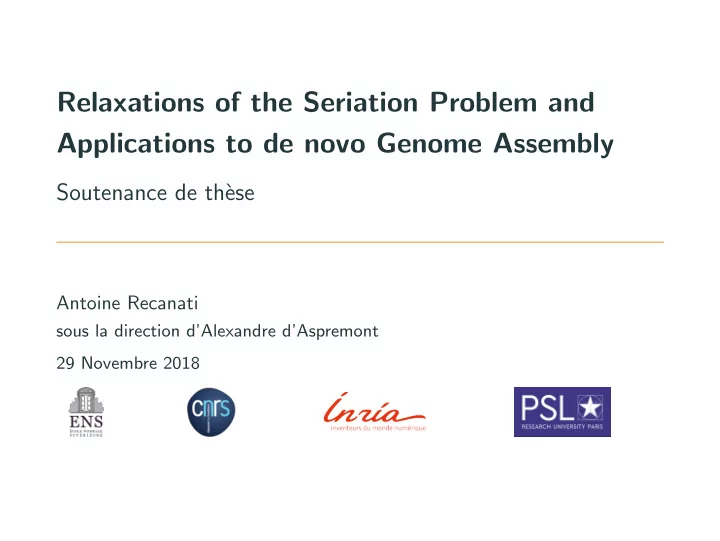

Relaxations of the Seriation Problem and Applications to de novo Genome Assembly Soutenance de th` ese Antoine Recanati sous la direction d’Alexandre d’Aspremont 29 Novembre 2018
Introduction
Genome sequencing ...ATGGCGTGCAATG... � ...TACCGCACGTTAC... 1
DNA sequencing Genome is cut into overlapping fragments ( reads ). Ex: ATGGCGTGCAATG Image: Nik Spencer/Nature 2
DNA sequencing Genome is cut into overlapping fragments ( reads ). Ex: ATGGCGTGCAATG CGTGCAA Image: Nik Spencer/Nature 2
DNA sequencing Genome is cut into overlapping fragments ( reads ). Ex: ATGGCGTGCAATG CGTGCAA ATGGCGT Image: Nik Spencer/Nature 2
DNA sequencing Genome is cut into overlapping fragments ( reads ). Ex: ATGGCGTGCAATG CGTGCAA ATGGCGT TGCAATG Image: Nik Spencer/Nature 2
DNA sequencing Genome is cut into overlapping fragments ( reads ). Ex: ATGGCGTGCAATG CGTGCAA ATGGCGT TGCAATG GGCGTGC Image: Nik Spencer/Nature 2
Assembly Goal: assemble reads together to reconstruct the full sequence. The position and ordering of the reads are unknown. ATGGCGTGCAATG CGTGCAA ATGGCGTGCAATG ATGGCGT � ATGGCGTGCAATG TGCAATG ATGGCGTGCAATG GGCGTGC ATGGCGTGCAATG 3
Genome assembly: mapping If reference genome available: map the fragments to it, then derive consensus sequence CGTGCAA ATGGCGT TGCAATG GGCGTGC 4
Genome assembly: mapping If reference genome available: map the fragments to it, then derive consensus sequence AAGGCGTGCATTG (ref. (proxy)) CGTGCAA ATGGCGT TGCAATG GGCGTGC 4
Genome assembly: mapping If reference genome available: map the fragments to it, then derive consensus sequence AAGGCGTGCATTG (ref. (proxy)) ATGGCGTGCAATG CGTGCAA ATGGCGT TGCAATG GGCGTGC 4
Genome assembly: mapping If reference genome available: map the fragments to it, then derive consensus sequence AAGGCGTGCATTG (ref. (proxy)) ATGGCGTGCAATG CGTGCAA ATGGCGTGCAATG ATGGCGT TGCAATG GGCGTGC 4
Genome assembly: mapping If reference genome available: map the fragments to it, then derive consensus sequence AAGGCGTGCATTG (ref. (proxy)) ATGGCGTGCAATG CGTGCAA ATGGCGT ATGGCGTGCAATG ATGGCGTGCAATG TGCAATG GGCGTGC 4
Genome assembly: mapping If reference genome available: map the fragments to it, then derive consensus sequence AAGGCGTGCATTG (ref. (proxy)) ATGGCGTGCAATG CGTGCAA ATGGCGTGCAATG ATGGCGT ATGGCGTGCAATG TGCAATG ATGGCGTGCAATG GGCGTGC 4
Genome assembly: mapping If reference genome available: map the fragments to it, then derive consensus sequence AAGGCGTGCATTG (ref. (proxy)) ATGGCGTGCAATG CGTGCAA ATGGCGTGCAATG ATGGCGT ATGGCGTGCAATG TGCAATG ATGGCGTGCAATG GGCGTGC 4
Genome assembly: mapping If reference genome available: map the fragments to it, then derive consensus sequence AAGGCGTGCATTG (ref. (proxy)) ATGGCGTGCAATG CGTGCAA ATGGCGTGCAATG ATGGCGT ATGGCGTGCAATG TGCAATG ATGGCGTGCAATG GGCGTGC ATGGCGTGCAATG (assembly) 4
Genome assembly: mapping If reference genome available: map the fragments to it, then derive consensus sequence AAGGCGTGCATTG (ref. (proxy)) ATGGCGTGCAATG CGTGCAA ATGGCGT ATGGCGTGCAATG ATGGCGTGCAATG TGCAATG GGCGTGC ATGGCGTGCAATG ATGGCGTGCAATG (assembly) 4
Genome assembly: de novo No reference available. Greedy assembly: take one read, “add” the one with largest overlap, etc., until all reads are included. CGTGCAA ATGGCGT TGCAATG GGCGTGC 5
Genome assembly: de novo No reference available. Greedy assembly: take one read, “add” the one with largest overlap, etc., until all reads are included. CGTGCAA ATGGCGTGCAATG ATGGCGT TGCAATG GGCGTGC ATGGCGTGCAATG 5
Genome assembly: de novo No reference available. Greedy assembly: take one read, “add” the one with largest overlap, etc., until all reads are included. CGTGCAA ATGGCGTGCAATG ATGGCGT TGCAATG ATGGCGTGCAATG GGCGTGC ATGGCGTGCAATG 5
Genome assembly: de novo No reference available. Greedy assembly: take one read, “add” the one with largest overlap, etc., until all reads are included. CGTGCAA ATGGCGTGCAATG ATGGCGT TGCAATG ATGGCGTGCAATG GGCGTGC ATGGCGTGCAATG ATGGCGTGCAATG 5
Genome assembly: de novo No reference available. Greedy assembly: take one read, “add” the one with largest overlap, etc., until all reads are included. CGTGCAA ATGGCGTGCAATG ATGGCGT ATGGCGTGCAATG TGCAATG ATGGCGTGCAATG GGCGTGC ATGGCGTGCAATG ATGGCGTGCAATG 5
De novo assembly paradigms • Greedy methods • De Bruijn graphs • Overlap-Layout-Consensus 6
Overlap-Layout-Consensus • Compute overlaps between all read pairs • Find tiling of reads consistent with overlaps • Average reads values to create consensus sequence ATGGCGTGCAATG CGTGCAA TGCAA ATGGCGTGCAATG CGT ATGGCGT ATGGCGTGCAATG CGTGC TGCAATG ATGGCGTGCAATG GGCGT TGC GGCGTGC ATGGCGTGCAATG 7
Modern sequencing technologies • 2nd gen. (SGS): short ( ∼ 100bp), accurate ( < 2% err.)reads (Illumina/Solexa), with pairing information. De Bruijn graphs methods (on k-mers based graph) preferred. • 3rd. gen.: long ( ∼ 10000bp), noisy ( ∼ 10%) reads (Pacific Biosciences [PacBio], Oxford Nanopore Technology [ONT]). Come-back of OLC methods. • Can be combined to have both accuracy and length ( hybrid methods ) 8
De novo assembly methods with ONT reads State of the art: Canu (ex. Celera Assembler). Heavy pre-processing , many heuristics • correction: (uses [hash-based] overlaps for consensus) • trimming: recalculate overlaps to filter low-coverage/high-error regions • re-computation of overlaps with specific target errors (uses a priori model of errors) • assemble unitigs (unambiguous sequences) first, then incremental scaffolding 9
De novo assembly methods with ONT reads • ONT-only assemblers (non-hybrid): active field of research 2015-now • Canu: complex pipeline, high quality consensus. • Miniasm: ideas of Canu assembly, no pre-processing, smart heuristics. Ultra-fast , low-quality . • Naive OLC approach with clean mathematical formulation ? 10
Introduction De novo Genome Assembly Seriation Application of the Spectral Method to Genome Assembly Robust Seriation Multi-dimensional spectral ordering Conclusion 11
Recommend
More recommend